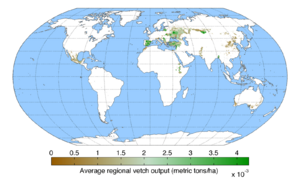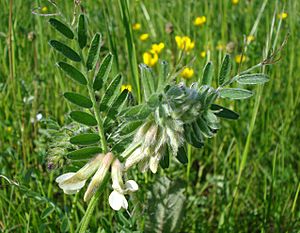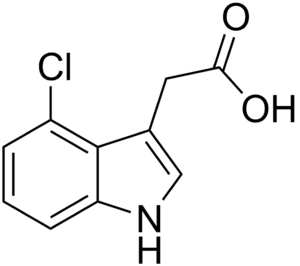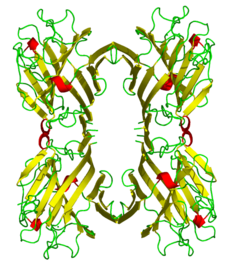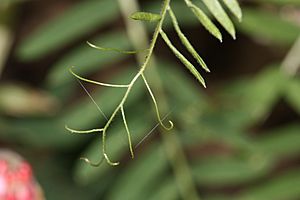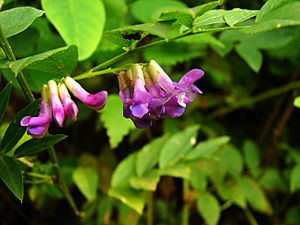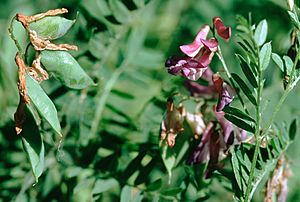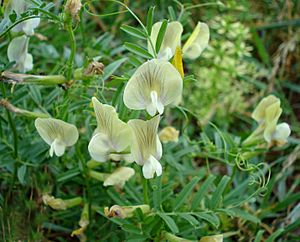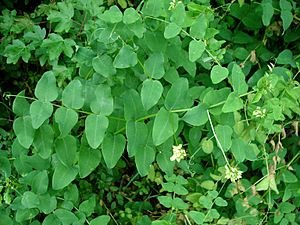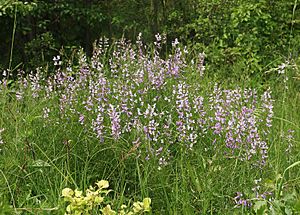Vicia facts for kids
Quick facts for kids Vicia |
|
|---|---|
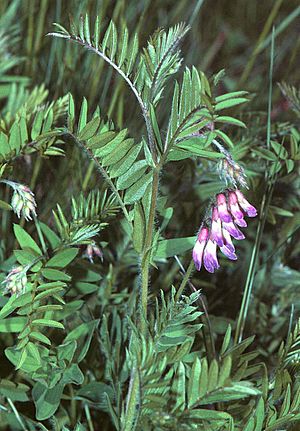 |
|
| Vicia orobus | |
| Scientific classification |
|
| Kingdom: | Plantae |
| Clade: | Tracheophytes |
| Clade: | Angiosperms |
| Clade: | Eudicots |
| Clade: | Rosids |
| Order: | Fabales |
| Family: | Fabaceae |
| Subfamily: | Faboideae |
| Tribe: | Fabeae |
| Genus: | Vicia L. |
| Type species | |
| Faba sativa Moench.
|
|
| Species | |
|
About 140, see text |
|
| Synonyms | |
|
|
Vicia is a group of over 240 different species of flowering plants. They belong to the legume family, called Fabaceae. These plants are commonly known as vetches. You can find them growing naturally in Europe, North America, South America, Asia, and Africa.
Other plants in the same family also have "vetch" in their names. Examples include vetchlings (Lathyrus) and milk-vetches (Astragalus). The broad bean (Vicia faba) is a very important vetch. It is sometimes put in its own group, Faba. This plant is so important that the larger plant group Fabales and the family Fabaceae are named after it. Vetches are closely related to lentils (Lens) and true peas (Pisum).
Contents
How Humans Use Vetches
One of the first plants humans ever grew was bitter vetch (Vicia ervilia). People started growing it in the Near East about 9,500 years ago. This was even before farming became common.
By about 7,000 years ago, people in Central Europe were also growing broad beans (Vicia faba). Seeds of broad beans have been found in ancient sites in Bulgaria, Hungary, and Slovakia. In Asia, people in Thailand also used broad beans as they began to farm.
Bernard of Clairvaux, a historical figure, ate bread made from vetch with his monks during a famine around 1124-1126. This showed their humility. Over time, bitter vetch became less common for humans to eat. It was mostly used only when people were starving.
However, broad beans remained a popular food. Ancient texts from the Hittites and Ancient Egypt mention broad beans over 3,000 years ago. They are also mentioned in the Bible. About 2,200 years ago, broad beans were found in a large Celtic town in Europe. Dishes similar to ful medames, which use broad beans, were eaten before 400 AD.
Today, the common vetch (Vicia sativa) is also very important. The Food and Agriculture Organization (FAO) lists it as one of the 11 most important legumes in the world. Common vetch is mostly used as forage to feed ruminant animals like cows. It is grown both as fodder (dried food) and as a fresh crop.
Other types of vetches have different uses. For example, tufted vetch (Vicia cracca) provides pollen for honey bees in mid-summer.
In 2017, the world produced over 920,000 tonnes of vetches. About 560,000 acres of land were used to grow them. More than half of this production came from Europe. Africa, Asia, the Americas, and Oceania also grew significant amounts.
Many types of vetches are grown to feed animals. These include hairy vetch (Vicia villosa), bard vetch (Vicia articulata), French vetch (Vicia serratifolia), and Narbon bean (Vicia narbonensis). Some vetches, like Vicia benghalensis and Hungarian vetch (Vicia pannonica), are also used as green manure. This means they are grown to improve the soil.
Vetches have many other uses too. Hairy vetch is good for improving soil and can help control weeds. Broad beans can absorb aluminum from the soil. This might make them useful for cleaning up polluted land. However, if they absorb too much aluminum, they might not be safe to eat.
These strong plants can also create a "beetle bank." This is a place where helpful beetles and other insects can live. These insects then eat pests that might harm crops. Broad beans can even grow well in salty soil if they are treated with certain bacteria and fungi.
Scientists have studied chemicals found in vetches. In the 1980s, a plant hormone called 4-Cl-IAA was found in Vicia amurensis and broad beans. Since 1990, special proteins called fabatin-1 and -2, which fight bacteria, have been found in broad beans.
Broad beans have a small number of chromosomes, but a lot of DNA. This makes them useful for testing if chemicals can harm DNA. A substance from Vicia graminea is used in medicine to test for a specific blood group.
Are Vetches Safe to Eat?
Vetches grown for animal feed can be harmful to animals that are not ruminants (like humans), especially if eaten in large amounts. Cows and horses have gotten sick from hairy vetch and V. benghalensis. These plants contain a toxic chemical called canavanine. Canavanine can make animals lose their appetite.
Narbon bean has a different chemical that acts faster but is less strong. Common vetch contains a chemical called β-cyanoalanine. This chemical can stop the body from making an important substance called cysteine. This can be dangerous if eaten with other toxins.
A Spanish mix of beans called comuña contains common vetch and bitter vetch. Animals can eat small amounts, but eating too much can cause a disease called lathyrism.
Common vetch and broad bean also contain chemicals like vicine and convicine. These can be harmful to people with a certain genetic condition called G6PD deficiency. For these people, eating these beans can cause a serious illness called favism. Raw broad beans also contain a protein called phytohemagglutinin, which can be poisonous.
Sometimes, split common vetch seeds look like split lentils. This has led to them being wrongly sold as lentils for people to eat. To prevent this, some countries, like Bangladesh and India, have banned imports of suspicious products.
Vetch in Nature
Vetches have special root nodules that help them take nitrogen from the air and put it into the soil. This makes them nitrogen-fixing plants, which is good for soil health. Their flowers are usually white, purple, or blue, but can also be red or yellow. Pollination happens when bumblebees, honey bees, and other insects visit the flowers.
Many butterfly and moth caterpillars eat Vicia species. Some examples include:
- Coleophora cracella – only eats Vicia species.
- Coleophora fuscicornis – only eats smooth tare (Vicia tetrasperma).
- Lime-speck pug (Eupithecia centaureata) – eats tufted vetch (V. cracca).
- Pea moth (Cydia nigricana)
Most other parasites and plant diseases that affect vetches are found on the broad bean. This is because broad bean is the most widely grown and important vetch. These include a mite called Balaustium vignae and several viruses.
Types of Vetches
- Vicia americana – American vetch
- Vicia amoena
- Vicia articulata – bard vetch
- Vicia benghalensis
- Vicia caroliniana – Carolina wood vetch
- Vicia cassubica – Kashubian vetch
- Vicia cracca – tufted vetch
- Vicia ervilia – bitter vetch
- Vicia faba – fava bean, broad bean
- Vicia graminea
- Vicia grandiflora
- Vicia hirsuta – hairy tare
- Vicia japonica
- Vicia lathyroides – spring vetch
- Vicia lutea – yellow vetch
- Vicia narbonensis – Narbon bean
- Vicia nigricans – black vetch
- Vicia orobus – upright vetch
- Vicia pannonica – Hungarian vetch
- Vicia pisiformis – pea-flowered vetch
- Vicia sativa – common vetch
- Vicia sepium – bush vetch
- Vicia serratifolia – French vetch
- Vicia sylvatica – wood vetch
- Vicia tenuifolia – fine-leaved vetch
- Vicia tetrasperma – smooth tare
- Vicia villosa – hairy vetch
Some plants that used to be called Vicia are now in other groups, like Lens nigricans.
What Does "Vicia" Mean?
The name Vicia comes from a Latin word meaning 'binder'. This name was used by Pliny the Elder, a Roman writer, for vetch plants.
The vetch is also mentioned in a famous story by Horace called 'The town mouse and country mouse'. In the story, the country mouse finds comfort in eating ervum (vetch) after a difficult visit to the city.
See also
 In Spanish: Vicia para niños
In Spanish: Vicia para niños


